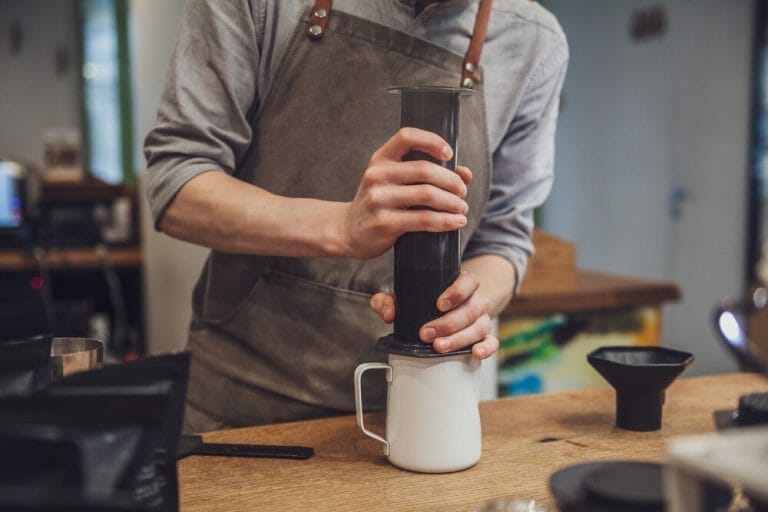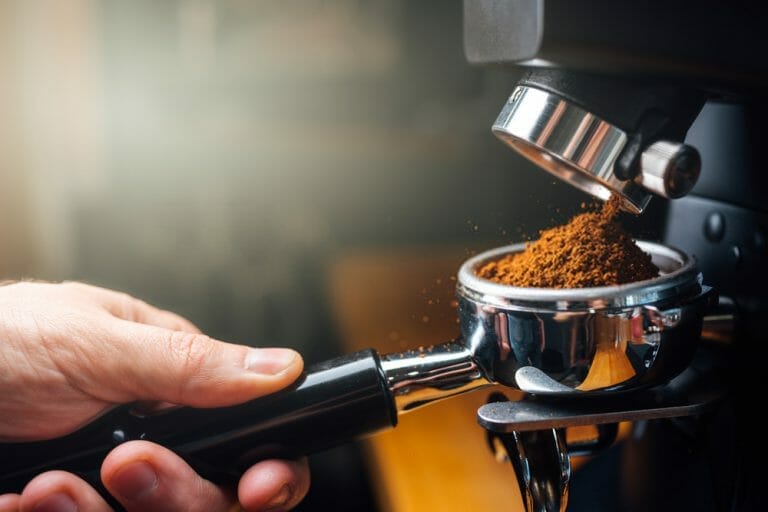How To Make Cuban Coffee Without An Espresso Maker?

Key Takeaways
- Traditional cane sugar is essential for sweetness in Cuban coffee, along with high-quality Arabica beans and filtered water.
- Stovetop brewing is a no-espresso-maker method for making Cuban coffee, with a fine grind similar to table salt.
- Espuma, or sugar foam, is essential for balancing the sweetness in Cuban coffee.
- Common mistakes when making Cuban coffee include over/under extraction, incorrect water temperature, and using stale beans.
You may be wondering how to make authentic Cuban coffee without an espresso machine, but fear not, it’s actually quite simple.
Before we dive into the recipe, let’s take a moment to appreciate the rich culture and history of Cuban coffee.
Coffee has been a staple in Cuban culture for over 200 years and is deeply ingrained in daily life.
It’s not just a beverage; it’s a symbol of hospitality and friendship.
Cuban coffee is traditionally made using dark roasted beans and brewed with sugar.
This method creates a sweet, strong shot of espresso known as cafecito or colada.
Not only does this technique enhance the flavor of the coffee, but it also allows for variations such as cortadito (espresso with steamed milk) or cafe con leche (coffee with milk).
In addition to its delicious taste, Cuban coffee offers health benefits such as improved cognitive function and decreased risk of certain diseases.
Its popularity has even extended beyond Cuba, making appearances in popular culture through films like Scarface and TV shows like Miami Vice.
Ingredients: What You’ll Need

First, let’s gather all the necessary ingredients for this delicious cup of Cuban-style caffeine.
To make Cuban coffee without an espresso maker, you’ll need high-quality Arabica coffee beans and filtered water to ensure a smooth and rich flavor.
Traditional cane sugar is also essential to add a unique sweetness that complements the boldness of the coffee.
The table below provides a breakdown of each ingredient’s role in making the perfect cup of Cuban coffee using the stovetop method.
Additionally, brewing tips are included to help you achieve your desired strength and taste.
For those who prefer sugar alternatives, there are options such as honey or agave nectar that can be used instead of traditional cane sugar.
| Ingredient | Role | Quantity |
|---|---|---|
| High-Quality Arabica Coffee Beans | Provides a smooth and rich flavor | 1/4 Cup |
| Filtered Water | Ensures purity and quality of taste | 1/2 Cup |
| Traditional Cane Sugar (or alternative) | Adds sweetness to complement boldness | 1-2 Tbsp |
Using a milk frother can also enhance the texture and richness of your Cuban coffee.
Just heat up some milk on the stove or microwave until it reaches your desired temperature, then use the frother to create creamy foam for that perfect finishing touch.
With these tips and ingredients at hand, you’re ready to make an authentic Cuban-style caffeine fix right from your own kitchen!
The No-Espresso-Maker Method: Step-by-Step Guide

- Gather your ingredients. You will need:
- 1 cup of water
- 2 tablespoons of coarsely ground coffee
- 1/4 cup of sugar
- A Moka pot
- A measuring cup
- A mug
- Fill the bottom chamber of the Moka pot with water. The water should come up to the valve.
- Add the ground coffee to the filter basket. Tamp the coffee down lightly.
- Screw the top of the Moka pot on tightly.
- Place the Moka pot on the stove over medium heat.
- As the coffee begins to brew, watch for the first few drops to come out of the spout. When you see these drops, remove the Moka pot from the heat.
- Immediately add the sugar to the measuring cup.
- Pour the first few drops of coffee from the Moka pot into the measuring cup with the sugar.
- Vigorously stir the coffee and sugar together until the sugar dissolves and the mixture forms a thick foam.
- Pour the remaining coffee from the Moka pot into the mug.
- Top with the foamy mixture.
- Enjoy!
The Magic Touch: Creating the Perfect Sugar Foam
Get ready to add a touch of magic to your coffee with the traditional sugar technique of creating the perfect ‘espuma’ or sugar foam.
Creating a sweet balance in your Cuban coffee culture requires mastering this art, and it’s easier than you think.
To start, grab a bowl and whisk together one tablespoon of sugar with two tablespoons of freshly brewed coffee until the mixture is frothy and light.
Next, pour the remaining coffee into a serving cup leaving enough room for the espuma on top.
Then, slowly pour the frothed mixture over your cup of coffee while holding the spoon just above its surface.
The key is to create bubbles that float on top without sinking into your drink– this foam perfection takes practice but once you’ve got it down pat, it’ll become an iconic part of your daily routine.
Did you know that espuma has been an integral part of Cuban coffee tradition since the early 20th century when it was first introduced as a way to prepare stronger espresso shots by adding less water?
Serve Like a True Cuban: Demitasses and More

Immerse yourself in the rich cultural traditions of Cuban coffee by appreciating the elegant serving style of small demitasses.
These tiny cups, typically holding only one to two ounces of coffee, are perfect for showcasing the strong and bold flavors that make Cuban coffee so unique.
They also encourage social interaction among friends and family, as it’s customary to share a round of shots with those around you.
When it comes to demitasses etiquette, there are a few things you should keep in mind.
First and foremost, always serve your guests their coffee with a saucer underneath – this not only protects surfaces from heat damage but also adds an extra layer of elegance to the presentation.
It’s also traditional to offer sugar cubes or sweetened condensed milk alongside the coffee so that each person can customize their drink according to their preferences.
And don’t forget about regional variations – while demitasses are most commonly associated with Cuba, they’re also prevalent throughout Latin America and Europe, each country putting its own unique spin on how they’re served.
Common Mistakes When Brewing Cuban Coffee and How to Avoid Them
Now that you know how to correctly serve Cuban coffee in traditional demitasses, let’s talk about common mistakes when brewing this delicious beverage.
To achieve the perfect flavor balance, it’s crucial to avoid over or under extracting the coffee.
This can happen if you don’t use the correct grind size or steeping time. The ideal grind size for Cuban coffee is fine and powdery, similar to espresso, and the optimal steeping time is between 30 seconds and two minutes.
Another important factor in achieving a flavorful cup of Cuban coffee is water temperature.
If your water is too hot, it can scorch the coffee and ruin the taste. On the other hand, if it’s not hot enough, it won’t extract all of the flavors from the beans.
The recommended water temperature for brewing Cuban coffee is around 200°F (93°C).
Lastly, make sure you’re using freshly ground coffee beans that are appropriate for your preferred roast type.
By avoiding these common brewing mistakes and following these tips, you’ll be able to enjoy a perfectly balanced cup of Cuban coffee every time – no espresso maker necessary!
Pro Tips: Making the Most of Your Homemade Cuban Coffee
To elevate your homemade Cuban coffee experience, try these expert tips for perfect pairing ideas, the best time to consume it, and the ideal coffee-to-sugar ratio.
- Experiment with different roasts to find your preferred flavor profile. A lighter roast will give a milder taste while a darker roast will have a bolder flavor. So, try out different variations to find the perfect flavor for you.
- Use evaporated milk or sweetened condensed milk for a traditional Cuban coffee experience. However, you can also try using almond milk or coconut cream if you prefer dairy-free options.
- To save time on busy mornings, pre-mix sugar and espresso in equal parts and store it in an airtight container. This way you can easily make your Cuban coffee by adding hot water.
- The standard Cuban coffee recipe includes two teaspoons of sugar for every shot of espresso. But, feel free to adjust the sweetness level according to your preference.
- Different roasts bring out different flavors in your Cuban coffee. A medium roast is the most common type used for making this beverage but if you want something stronger go for dark-roast beans instead. Remember that darker roasts produce more bitter flavors so be careful not to overdo it!
Remember, with these pro tips, you can enjoy a delicious and customized cup of Cuban coffee anytime.
FAQs
Final Thoughts
So why not take your love for Cuban coffee to the next level and try out these pro tips?
Elevate your morning routine and discover new flavor combinations with just a few simple adjustments.
One of the benefits of Cuban coffee is that it’s strong, flavorful, and full-bodied. By using high-quality beans from the best Cuban coffee brands, you can ensure a rich taste that will tantalize your senses.
Compared to other types of coffee, Cuban coffee has a unique history dating back to the 1800s when it was first introduced as a way to sustain workers in sugar plantations.
Today, popular Cuban coffee drinks include café con leche (coffee with milk), cortadito (espresso with steamed milk), and colada (a large pot of espresso served in small cups).
With these pro tips in mind, you can enjoy an authentic taste of Cuba right from the comfort of your own home.






